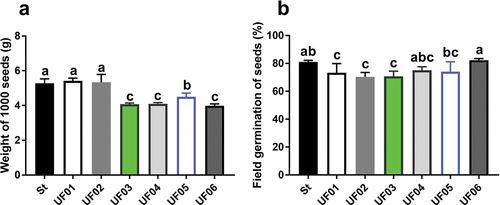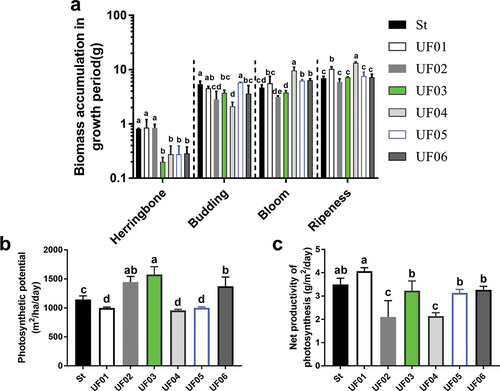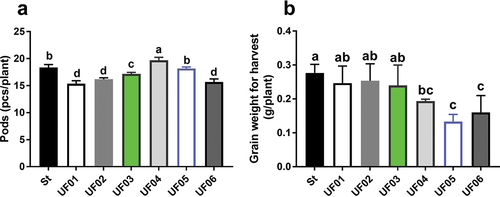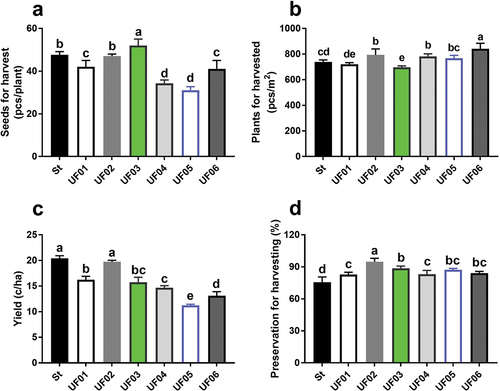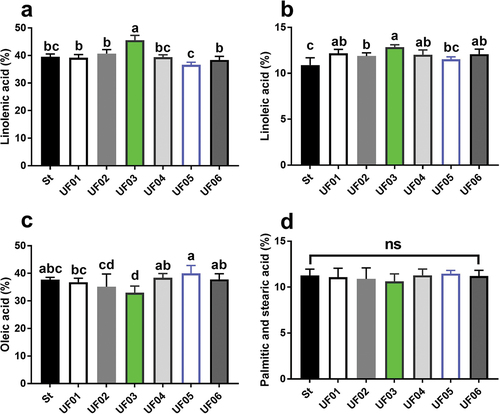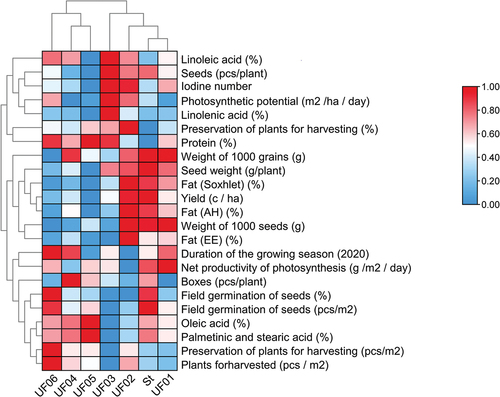 ?Mathematical formulae have been encoded as MathML and are displayed in this HTML version using MathJax in order to improve their display. Uncheck the box to turn MathJax off. This feature requires Javascript. Click on a formula to zoom.
?Mathematical formulae have been encoded as MathML and are displayed in this HTML version using MathJax in order to improve their display. Uncheck the box to turn MathJax off. This feature requires Javascript. Click on a formula to zoom.ABSTRACT
Oil flax stems are often burnt because of the low fiber content; this issue is especially serious in Kazakhstan. To solve this problem, this study aimed to determine which flax resources could exhibit a significant increase in stem yield without a decrease in seed yield. In a previous study in 2019, we tested seven types of flax stems at the research site of the S. Seifullin KATU campus. Here, a further investigation of the same resources, which was conducted in 2020, is described. According to the results, the UF03, UF05, and UF06 showed higher dynamics of plant height in the budding and blooming stages compared to a local Kazakhstani variety; this result greatly differed compared with the data from 2019. UF03 yielded the best oil quality, especially in terms of the linolenic acid and linoleic acid contents. UF02 had good performance in terms of yield and the largest fat content of all resources. More foreign flax resources should be introduced to improve the development of the flax industry in Kazakhstan.
摘要
油用亚麻常因茎的纤维含量低而被丢弃焚烧,这个问题在哈萨克斯坦尤为严重。 因此,发掘出茎产量高、种子产量不降低的亚麻资源成为了本研究的重点。2019年,我们在位于哈斯克斯坦的赛福林农业技术大学基地试验了7种不同亚麻资源的产量情况。在此基础上,本研究于2020年对这些资源进行了进一步研究。研究结果表明,与哈萨克斯坦当地资源相比,UF03、UF05和UF06在现蕾期和花期表现出更高的株高,这与2019年的试验结果一致。UF03油脂品质最佳,亚麻酸和亚油酸含量显著高于其他资源。UF02在产量方面表现较好,并拥有最高的脂肪含量。因此,引进更多的国外亚麻资源对促进哈萨克斯坦亚麻产业的发展,很有必要。
Introduction
As a valuable oilseed crop, flaxseed contains a rapidly drying oil (iodine number 165–192; constituting 38–45% of the seed), which is highly valued in paint and varnish production. This oil is commonly used as a high-quality industrial oil used in the production of leather, soap, paper, perfumery, rubber, electrical equipment, and medicine (Saini et al. Citation2021). Flaxseed oil has the following technical parameters: its pour point is within 8–27°C, and its saponification number is 186–195 (Gao, Qun, and Zhen Citation2017). The iodine number of flaxseed oil is characteristic of its quick drying capacity; the larger the number, the better the drying ability. Its ability to dry quickly and form a strong, thin, elastic film is useful for preparing the best varieties of natural drying oil, as well as special varnishes, primers, and enamels (Wang et al. Citation2021).
Flaxseed oil is also used for cooking oil, waste oil (cake and meal), and as a valable concentrated feed containing 31–38% digestible protein. As a high-protein feed, flaxseed cake is added to cow feed, contributing to an increased milk yield and fat content. In addition, briquettes made from flaxseed material are highly flammable and can be used as a high-calorific fuel (Goyal et al. Citation2014). Furthermore, flax straw can be processed into tow and short fibers, from which burlap, brucite, and heat-insulating materials are produced. This fiber is commonly used in the pulp and paper industry (Dey et al. Citation2021; Goyal et al. Citation2014; Wang et al. Citation2012).
Demand for flaxseed oil has increased in recent years, while that for sunflower and rapeseed oil has remained within normal industry-wide fluctuations (Ruiyan and Feihu Citation2010). This is due to the fact that flaxseed oil is an export product in China, and the volume of flaxseed crops depends on existing contracts or intentions for its supply (Saini et al. Citation2021). Additionally, the industrial processing of flax seeds differs from that of other oilseeds. Due to the peculiarities of flaxseed oil, it requires not only direct extraction but also deep processing in terms of further extraction, refining, and deodorization (Landete Citation2012; Zeleny, Coleman, and Chemist, and Civision Citation1936). The main importers of flax from the Republic of Kazakhstan are countries in the European Union, among which Belgium clearly stands out. Additionally, Kazakhstan steadily exports flax to Afghanistan and Turkey. The shipment of Kazakhstani flaxseed is carried out in accordance with the ISO 658 requirements for oilseeds. In 2020, the total volume of exports of all oilseeds from Kazakhstan amounted to 880,000 tons (Mukhambet et al. Citation2022). Therefore, the cultivation of flaxseed is of enormous importance in Kazakhstan.
Flax is a valuable oilseed and industrial crop, because of its high level for production profitability. As a short growing season and drought resistance crop, it was suitable for cultivation in the conditions of northern Kazakhstan. This work was conducted in 2019 firstly, and referring to the 2019 study, the present study considers further details related to the previously obtained scientific results. Structural elements, biological and physiological characteristics, oil quality, and fiber content was assayed in the test flax resources. This study provides a new approach for flax use in Kazakhstan.
Material and methods
The research site on the S. Seifullin KATU campus consists of an undulating plain with isolated hills scattered over its surface (51°40’5.843“N, 71°0’9.472” E, about 350 m a.s.l.). Groundwater occurs at a depth of 25–30 m, constituting both fresh and saltwater, with freshwater being more prevalent. The groundwater does not form a continuous water horizon. In terms of agroclimatic zoning, the research site belongs to zone II (slightly humid, moderately warm), characterized by K = 0.8–1.0 and temperatures typically above 10°C. According to weather stations located in Astana, Kazakhstan, the annual sum of total solar radiation in the Akmola region ranges from 6,100 to 6,500 MJ/m2 under clear sky conditions and from 4,600 to 5,000 MJ/m2 under average cloudy conditions. The average monthly air temperature reaches its highest value in July and the lowest in January. The average air temperature for July is 20.7°C, and the average for January is minus 14.50°C. The daily amplitude of air temperature decreases from summer to winter. For example, the daily temperature range in June is 13.7–13.9°C, and in January it ranges from −9.0 to 9.9°C. The soils of the experimental plot are typical for the steppe zone of northern Kazakhstan dark chestnut with a light mechanical composition, with rather low potential fertility (humus content is low, humus content of 3.5%), the content of nitrate nitrogen, mobile phosphorus and sulfur and a high content of exchangeable potassium. Soil density in the arable 0–20 cm layer was 1.23 g/cm3 (on average over the horizon), 1.38 g/cm3 in the 20–50 cm layer, and 1.58 g/cm3 in the 50–100 cm layer, with medium density. Productive moisture in the meter layer of soil in the first and second decades of May, before sowing perennial grasses due to autumn-winter and spring precipitation, was at a good moisture level and averaged 148.4 and 124.5 mm, respectively.
In this study, we tested seven flaxseed resources. The local flax variety Kostanay amber (St) was used as the standard, and resources UF01, UF02, UF03, UF04, UF05, and UF06 from foreign countries were used as tested resources. Sowing was carried out manually to a depth of 3 cm on May 22, 2020, and 12 million viable seeds were sowed per hectare. After sowing, rolling was carried out. The seeding rate was 12 million viable seeds per hectare. Field experiments were carried out in plot areas of 5 m × 2 m. Three repetitions were carried out for each variety, and the plot area locations were randomly selected. The germination of seeds in the field as well as the density of the plants, were assessed by counting the fully germinated seeds and plants in four fixed 0.25-m2 subplots in all plots according to the method of Qiu et al (Caisheng et al. Citation2022).
Measurements of photosynthesis
Gas exchange and photosynthesis were measured as described by Han et al. Photosynthesis and related parameters were measured on the youngest fully expanded leaves of young seedlings with an LI-6400XT portable photosynthesis system (Li-Cor Inc., Lincoln, NE, USA). Air temperature in the cuvette was set to ambient temperature during measurement, and the photosynthetic photon flux intensity (PPFD) was set to 1000 μmol·m−2·s−1; CO2 concentration in the cuvette was adjusted to 400 ppm with a CO2 mixer, and relative humidity was 65%. Data were recorded after steady-state equilibrium was achieved. After photosynthetic determination, chlorophyll concentration was determined using SPAD-502 (Minolta Camera Co., Ltd.). Six replicates were used for measurements. The Photosynthetic N use efficiency (PNUE) and Harvest index were calculated using the following equations (Raineri et al. Citation2022):
Determination of the ratio of fatty acids in flax seed oil
The determination of fatty acid ratio in oilseed oil was determined by the method of refractometry according to the methodological instructions (Wang et al. Citation2021). The method is based on an indicator of the use of oil, through which the iodine number and the content of essential fatty acids in oilseeds can be determined by mathematical calculation.
Resistance to lodging and shedding
The resistance of the studied resources to plant lodging and seed shedding was assessed according to the same point system. This assessment was carried out during the ripening period of the flax (Dey et al. Citation2022). shows the results of the evaluation of different resources of legumes and oilseeds for resistance to plant lodging and shedding of seeds. According to the indicator results, all studied flax resources were non-shedding forms.
Table 1. Assessment of the resistance of flax varieties of oilseeds to lodging and shedding, points.
Statistical analysis
The statistical significance of differences between treatments was analyzed using IBM SPSS Statistics 22.0. Data were compared by two-way analysis of variance (ANOVA) and Tukey’s HSD post hoc test at a significance level of p < .05. The data in the tables are presented as mean ± standard deviation (SD). Figures were constructed using GraphPad Prism 7.04 (Wu et al. Citation2019).
Results
Field germination and plant survival
Before sowing the seed material, which was taken from the 2019 harvest, the weight of 1000 seeds of each flaxseed variety was determined (). Compared with that in St, the seed weight was significantly decreased in UF03, UF04, UF05, and UF06, and there were no significant differences in UF01 and UF02. The field germination of the flaxseeds ranged from 66.2% to 83.3% across different resources. The germination was 12.1% higher for local variety St than for six nonlocal resources. It should be noted that local resources are more adapted to the arid conditions of the research area than are resources transported from elsewhere. The best field germination was observed in UF06 at 83.3%, which exceeded that of other resources by an average of 8.98%. The plant preservation of the tested flaxseed resources was high, amounting to 75.5–92.4%. The field germination for flax varieties from abroad was 12.8% higher than that of local resources. The harvested plant density ranged from 6.8 to 8.5 million plants per hectare (689 plants/m2; ).
Growth and development of different flax plant resources
In 2019, the standard flax height in the budding phase was 27.3 cm, and the other resources during this period had a height of 31.2–52.7 cm, which was above the standard height of 5.9–24.4 cm. In the flowering phase, the plant height was 3.6–23.0 cm. The tallest plants in the flowering phase were plants of variants UF04, UF05, and UF06, with heights of 59.0, 55.0, and 53.7 cm, respectively. In both the budding and blooming stages, the six nonlocal resources were taller than the local variety St (). In the herringbone stage, there was no significant difference in height among different resources. The plant heights of the studied resources in 2019 and 2020 are presented in .
Figure 2. Field growth performance in 2019 and 2020. (a) Dynamics of plant height in 2019. (b) Dynamics of plant height in 2020. (c) Growing season in 2019 and 2020.
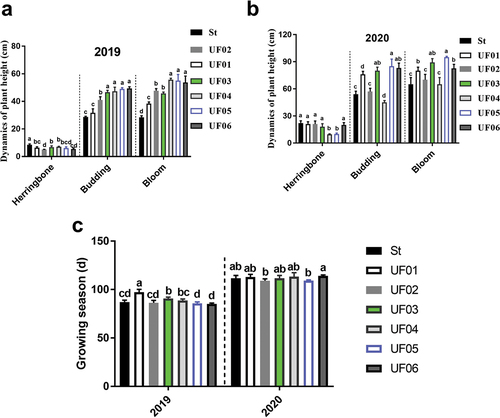
The growth dynamics of the flax plants in 2020 are shown in . In the herringbone stage, St, UF01, and UF02 showed a higher growth rate compared to other resources. In the budding stage, the growth rates of resources UF02, UF03, UF04, and UF05 were significantly decreased compared with that of St, especially for variety UF04. There were no significant differences in the growth rates of UF01 and UF05 compared to that of St. In the bloom stage, the growth rates of resources UF01, UF02, and UF03 were not significantly different compared to that of St; however, the growth rate was significantly increased in resources UF04, UF05, and UF06. In the ripening stage, the growth rates of resources UF02, UF03, UF05, and UF06 did not significantly differ compared to St, whereas those for UF01 and UF04 were significantly higher. At the end of the growing season, the tested flax resources reached heights of 65–100 cm. The nonlocal resources were distinguished by their tallness in comparison with the standard variety.
The growing season averaged 86 days in 2019 and 109 days in 2020 (). In 2019, the greatest growing season length was observed in the UF01 variety (98 days), and the shortest (86 days) was observed in the Kustanayskaya amber (St) variety. In 2020, the longest growing season was observed in the UF04 (112 days) and UF06 (112 days) resources, and the smallest was observed in the UF05 (107 days). The St variety had a growing season of 109 days ().
In the herringbone stage, the biomass accumulation of UF03, UF04, UF05, and UF06 was significantly decreased compared to that of St, but there were no significant differences for UF01 and UF02. In the budding stage, the biomass accumulation was significantly decreased in all resources, except for UF01 and UF05, compared to that for St, and UF04 showed the lowest accumulation. In the bloom stage, the accumulation was significantly increased in UF04, UF05, and UF06 compared to that in St. In the ripening stage, the accumulation was significantly increased in UF01 and UF04 compared to that in St (). A high rate of photosynthetic potential among flaxseed resources was noted, with that for UF03 (1.5542 million m2/ha/d) being higher than the control variant St by 370,700 m2/ha/d and that for UF02 (962,200 m2/ha/d) being the lowest, with a potential lower than the control variant by 221,300 m2/ha/d (). The net productivity of photosynthesis of the variant UF01 was higher, and that of the other variants was decreased compared with that of St ().
Elements of the flax yield structure
The field yield per plant was increased for resources UF04 compared to that for St (19.67 pcs/plant), and UF01 had the lowest field yield (15.33 pcs/plant; ). Regarding the number of pods number for per plant, variety UF04 had the most (20 boxes), though there were no significant differences among all resources. Regarding grain weight, St ranked first (0.28 g/plant), and variety UF05 ranked last (0.14 g/plant; ).
Consequently, the productivity of oilseeds and their fat content depended on the main elements of the yield structure. The number of seeds harvested was significantly higher for UF03 (52 seeds/plant) than for St, and UF05 had the lowest number of seeds (31 seeds/plant; ). Regarding the number of plants harvested, the range was 696.67–841.67 plants/m2. UF03 had the lowest number of harvested plants, and UF06 had the most (). The biological productivity of the oil flax ranged from 11.23 to 20.43 centners/ha (c/ha), depending on the varietal characteristics. The largest biological yield of oilseeds was harvested from the St variety in the amount of 20.43 c/ha (). Regarding the preservation of oilseeds, it ranged from 75.5% to 94.87%. The largest preservation occurred in variety UF02 in the amount of 94.87% (). Notably, the tested flax resources from abroad competed well with the St variety in terms of productivity and fat content of the seeds. Thus, these resources can be used to diversify crop production in the studied region.
Analysis of flax seed oil
For the weight of 1000 seeds, St had the largest weight, UF06 had the lowest weight, and the range across all resources was 3.89–5.89 g (). The fat content (EE) was in the range of 21.41–25.51%, with UF02 having the lowest fat content (21.41%) and UF05 having the highest (25.51%; ). The fat contents measured by the AH and Soxhlet methods were in the ranges 38.04–48.06% and 35.54–45.2%, respectively. Under these measurements, UF02 had the highest amount, and UF05 had the lowest amount (). The iodine number was in the range of 151.27–159.4%, with UF05 having the lowest iodine number and UF03 having the largest (). The protein content was in the range of 24.59–31.49%, with St having the lowest protein content and UF05 having the largest ().
Figure 6. The nutrition composition for grains. (a) Weight of 1000 grains. (b) the content for crude fat. (c) the content for fat by acid hydrolyzation. (d) the content for fat by Soxhlet. (e) Iodine number. (f) the content for Protein.

For the analysis of flaxseed oil, the oil was prepared using a laboratory press. The linolenic acid content of the seeds was in the range of 36.63–45.57%, with UF03 having the highest content and UF05 having the lowest (). The linoleic acid content ranged from 10.90% to 12.86%, with UF03 having the most and St having the least (). The oleic acid content ranged from 32.99% to 39.99%, with UF05 having the most and UF03 having the least (). There were no significant differences in the content of palmitic and stearic acid across the flax resources ().
Discussion
Field germination of seeds and the growth of seedlings depend on the conditions for the formation and maturation of seeds on the mother plant (Aoyama, Yamaguchi, and Sato Citation2018), as well as storage conditions and soil and climatic indicators in a given year during the period of seed germination (Wu et al. Citation2018). This indicator characterizes the ability of the seed to create full-fledged plants and is expressed as a percentage of the number of plants harvested from the number of seeds sown (Bakshi et al. Citation2018; Zhao et al. Citation2015; Zhu et al. Citation2009). Compared with St, almost all flax varieties from abroad exhibited a lower weight and germination rate. Thus, the adoption of flax resources from abroad in Kazakhstan requires further attention.
We analyzed the dynamics of the height of oil flax resources in 2019 and 2020. The growth of flax was significantly inhibited in 2019 because of poor weather conditions (Caisheng et al. Citation2022. Flax resources under the same development conditions did not have the same height during the growing season. For example, in the herringbone phase, the compared resources did not differ from each other in terms of plant height (Alcock et al. Citation2018). The height ranged between 5.0–8.5 cm (2019) and 13–22 cm (2020). Measurements in the budding phase showed that the linear growth of individual resources reached a height of 52.2–52.7 cm in 2019 and 45–85 cm in 2020. The life cycle of a plant is defined by two main phases: growth and development (de la Torre et al. Citation2014; McLoughlin et al. Citation2020). The growth of plant tissue and organs occurs because of cell division and increases in cell volume (Nagai et al. Citation2020; Rose Citation2017).
The specific conditions related to soil cultivation, the accumulation of moisture and nutrients, and the prevailing meteorological conditions of the year have a significant impact on the formation of flax biomass (Dey et al. Citation2021), regardless of the variety (Ma et al. Citation2020; Xu, Fan, and Miller Citation2012). Here, we studied the accumulation dynamics of green mass during all phases of the growing season. In the blooming and ripening stages, the biomass accumulation of UF04 and the number of pods per plant were significantly increased compared with those of St (). For a single plant, a large accumulation of biomass (as a whole per unit area) is a prerequisite for obtaining a high yield of flaxseeds (Bhusal et al. Citation2022; She et al. Citation2011).
UF02 and UF03 showed good yield performance
UF03 had a significantly higher seed number compared with St (), and resources UF02 and UF06 had a higher number of harvested plants (). Finally, UF02 had the best performance in yield and preservation during the harvest stage (). The yield level results from the impact of several factors, such as the soil conditions, climate, biological characteristics of the plant, and agricultural techniques (Dubois, Van den Broeck, and Inzé Citation2018a; Wang et al. Citation2021). In nature, it is difficult to find any phenomenon that would have absolutely no effect on crop formation. High crop productivity is achieved by creating optimal conditions and providing plants with access to vital requirements during the entire growing season (Dubois, Van den Broeck, and Inzé Citation2018b). Our research showed that, under equivalent conditions, the varietal characteristics of crops significantly impact the size and quality of the yield of flaxseeds.
UF03 showed good performance in terms of oil quality
Of all the tested resources, UF03 and UF05 showed the most significant differences in terms of quality. UF03 had an exceedingly high iodine number and content of linolenic acid and linoleic acid, though it had the lowest amounts of oleic, palmitic, and stearic acids. Meanwhile, UF05 showed the reverse trend (). The quality of flax oilseeds was assessed () using a method based on a mathematical indicator that considers the iodine number and the content of essential fatty acids in the oilseeds (Wang et al. Citation2021). To determine the oil and protein contents in the flaxseeds, we took assessed the fat content and other indicators of seed samples. The results showed that the fat content in flaxseeds varied depending on the flax variety. Chemical analysis revealed that the flaxseeds had a particularly high nutritional value, but the protein content varied depending on the varietal characteristics (Goyal et al. Citation2014).
Conclusions
In this study, we tested seven flax resources in Kazakhstan in 2020 and compared the results with those of a similar study conducted in 2019. This comparative study between six nonlocal flax and a variety of Kazakhstan flax showed that in the steppe zone of northern Kazakhstan, the oil seeds had a good yield (11.4–21.7 c/ha). Variety UF02 had the highest fat content. Variety UF03 had a high iodine number and contents of linolenic and linoleic acids, but it had the lowest amounts of oleic, palmitic, and stearic acids. The six tested resources showed good results in terms of flaxseed productivity and oil content. Considering the acute problem of stem burning in Kazakhstan, dual-purpose flax might be a suitable option.
Highlights
Foreign flax resources should be introduced to improve the development of the flax industry in Kazakhstan.
UF02 had good performance in terms of yield and the largest fat content of all resources in Kazakhstan.
Considering the acute problem of stem burning in Kazakhstan, dual-purpose flax might be a suitable option.
Disclosure statement
No potential conflict of interest was reported by the author(s).
Additional information
Funding
References
- Alcock, M., S. Ahmed, S. DuCharme, and C. A. Ulven. 2018. Influence of stem diameter on fiber diameter and the mechanical properties of technical flax fibers from linseed flax. Fibers 6 (1). doi: 10.3390/fib6010010.
- Aoyama, S., J. Yamaguchi, and T. Sato. 2018. Methods for elucidation of plant senescence in response to C/N-Nutrient balance. Methods in Molecular Biology 1744:151–13. doi:10.1007/978-1-4939-7672-0_14.
- Bakshi, A., S. Piya, J. C. Fernandez, C. Chervin, T. Hewezi, and B. BM. 2018. Ethylene receptors signal via a noncanonical pathway to regulate abscisic acid responses. Plant Physiology 176 (1):910–29. doi:10.1104/pp.17.01321.
- Bhusal, N., A. Adhikari, M. Lee, A. Han, A. R. Han, and H. S. Kim. 2022. Evaluation of growth responses of six gymnosperm species under long-term excessive irrigation and traits determining species resistance to waterlogging. Agricultural and Forest Meteorology 323 (June):109071. doi:10.1016/j.agrformet.2022.109071.
- Caisheng, Q., G. Stybayev, W. Yufu, A. Begalina, L. Songhua, A. Baitelenova, G. Yuan, S. Arystangulov, K. Qinghua, G. Kipshakpayeva, et al. 2022. Flax varieties experimental report in Kazakhstan in 2019. Journal of Natural Fibers 19 (6):2356–65. doi:10.1080/15440478.2020.1813674.
- de la Torre, F., R. A. Cañas, M. B. Pascual, C. Avila, and F. M. Cánovas. 2014. Plastidic aspartate aminotransferases and the biosynthesis of essential amino acids in plants. Journal of Experimental Botany 65 (19):5527–34. doi:10.1093/jxb/eru240.
- Dey, P., B. S. Mahapatra, B. Pramanick, S. Pyne, and P. Pandit. 2022. Optimization of seed rate and nutrient management levels can reduce lodging damage and improve yield, quality and energetics of subtropical flax. Biomass & bioenergy 157 (January):106355. doi:10.1016/j.biombioe.2022.106355.
- Dey, P., B. S. Mahapatra, J. VK, B. Pramanick, M. S. Negi, J. Paul, and S. Singh. 2021. Flax processing waste – a low-cost, potential biosorbent for treatment of heavy metal, dye and organic matter contaminated industrial wastewater. Industrial Crops and Products 174 (May):114195. doi:10.1016/j.indcrop.2021.114195.
- Dubois, M., L. Van den Broeck, and D. Inzé. 2018a. The pivotal role of ethylene in plant growth. Trends in Plant Science 23 (4):311–23. doi:10.1016/j.tplants.2018.01.003.
- Dubois, M., L. Van den Broeck, and D. Inzé. 2018b. The pivotal role of ethylene in plant growth. Trends in Plant Science 23 (4):311–23. doi:10.1016/j.tplants.2018.01.003.
- Gao, X., G. Qun, and Zhen. 2017. Discussion on standard of high-quality linseed oil. Journal of Shanxi Agricultural Sciences 45 (12):2049–51. doi:10.3969/j.issn.1002-2481.2017.12.35.
- Goyal, A., V. Sharma, N. Upadhyay, S. Gill, and M. Sihag. 2014. Flax and flaxseed oil: An ancient medicine & modern functional food. Journal of Food Science and Technology 51 (9):1633–53. doi:10.1007/s13197-013-1247-9.
- Landete, J. M. 2012. Plant and Mammalian Lignans: A review of source, intake, metabolism, intestinal bacteria and health. Food Research International 46 (1):410–24. doi:10.1016/j.foodres.2011.12.023.
- Ma, M., D. Wendehenne, L. Philippot, R. Hänsch, E. Flemetakis, B. Hu, and H. Rennenberg. 2020. Physiological significance of pedospheric nitric oxide for root growth, development and organismic interactions. Plant, Cell & Environment 43 (10):2336–54. doi:10.1111/pce.13850.
- McLoughlin, F., R. S. Marshall, X. Ding, E. C. Chatt, L. D. Kirkpatrick, R. C. Augustine, F. Li, M. S. Otegui, and R. D. Vierstra. 2020. Autophagy plays prominent roles in amino acid, nucleotide, and carbohydrate metabolism during fixed-carbon starvation in maize. The Plant Cell 32 (9):2699–724. doi:10.1105/TPC.20.00226.
- Mukhambet, Y., D. Shah, G. Tatkeyeva, and Y. Sarbassov. 2022. Slow pyrolysis of flax straw biomass produced in Kazakhstan: Characterization of enhanced tar and high-quality biochar. Fuel 324 (PB):124676. doi:10.1016/j.fuel.2022.124676.
- Nagai, K., Y. Mori, S. Ishikawa, T. Furuta, R. Gamuyao, Y. Niimi, T. Hobo, M. Fukuda, M. Kojima, Y. Takebayashi, et al. 2020. Antagonistic regulation of the gibberellic acid response during stem growth in rice 584.
- Raineri, J., L. Caraballo, N. Rigalli, M. Portapila, M. E. Otegui, and R. L. Chan. 2022. Expressing the sunflower transcription factor HaHB11 in maize improves waterlogging and defoliation tolerance. Plant Physiology 189 (1):230–47. doi:10.1093/plphys/kiac054.
- Rose, L. 2017. Pitfalls in root trait calculations: how ignoring diameter heterogeneity can lead to overestimation of functional traits. Frontiers in Plant Science 8 (May):1–5. doi:10.3389/fpls.2017.00898.
- Ruiyan, S., and L. Feihu. 2010. Origin of flax as well as its cultivation and utilization in China. Plant Fiber Sciences in China 32 (5):282–86.
- Saini, R. K., P. Prasad, R. V. Sreedhar, K. Akhilender Naidu, X. Shang, and Y. S. Keum. 2021. Omega−3 Polyunsaturated Fatty Acids (PUFAs): Emerging plant and microbial sources, oxidative stability, bioavailability, and health benefits—a review. Antioxidants 10 (10). doi: 10.3390/antiox10101627.
- She, W., Y. C. Jie, H. C. Xing, Z. Q. Luo, W. L. Kang, M. Huang, and S. J. Zhu. 2011. Absorption and accumulation of cadmium by ramie (boehmeria nivea) cultivars: A field study. Acta Agriculturae Scandinavica Section B: Soil and Plant Science 61 (7):641–47. doi:10.1080/09064710.2010.537678.
- Wang, Z., N. Hobson, L. Galindo, S. Zhu, D. Shi, J. McDill, L. Yang, S. Hawkins, G. Neutelings, R. Datla, et al. 2012. The genome of flax (linum usitatissimum) assembled de novo from short shotgun sequence reads. Plant Journal 72 (3):461–73. doi:10.1111/j.1365-313X.2012.05093.x.
- Wang, X., M. W. Li, F. L. Wong, C. Y. Luk, C. Y. Chung, W. S. Yung, Z. Wang, M. Xie, S. Song, G. Chung, et al. 2021. Increased Copy number of gibberellin 2-oxidase 8 genes reduced trailing growth and shoot length during soybean domestication. Plant Journal 107 (6):1739–55. doi:10.1111/tpj.15414.
- Wu, Z., J. Luo, Y. Han, Y. Hua, C. Guan, and Z. Zhang. 2019. Low nitrogen enhances nitrogen use efficiency by triggering NO₃− uptake and its long-distance translocation. Journal of Agricultural & Food Chemistry 67 (24):6736–47. doi:10.1021/acs.jafc.9b02491.
- Wu, D., X. Yu, S. Chu, D. F. Jacobs, X. Wei, C. Wang, F. Long, X. Chen, and S. Zeng. 2018. Alleviation of heavy metal phytotoxicity in sewage sludge by vermicomposting with additive Urban plant litter. The Science of the Total Environment 633:71–80. doi:10.1016/j.scitotenv.2018.03.167.
- Xu, G., X. Fan, and A. J. Miller. 2012. Plant nitrogen assimilation and use efficiency. Annual Review of Plant Biology 63:153–82. doi:10.1146/annurev-arplant-042811-105532.
- Zeleny, L., D. A. Coleman, and Chemist, and Civision. 1936. The refractometric determination of iodine number in flaxseed oils. Oil & Soap 5:253–56. doi:10.1007/BF02574461.
- Zhao, F. Y., C. J. Jiao, Q. Chen, T. C. WangTs, and Y. M. Gao. 2015. PKS5 kinase is involved in ABA response through phosphorylating ABI5 in arabidopsis. Zhiwu Shengli Xuebao/Plant Physiology Journal 51 (10):1719–28. doi:10.13592/j.cnki.ppj.2015.0273.
- Zhu, Y., T. Di, G. Xu, X. I. Chen, H. Zeng, F. Yan, and Q. Shen. 2009. Adaptation of plasma membrane H±ATPase of rice roots to low PH as related to ammonium nutrition. Plant, Cell & Environment 32 (10):1428–40. doi:10.1111/j.1365-3040.2009.02009.x.

